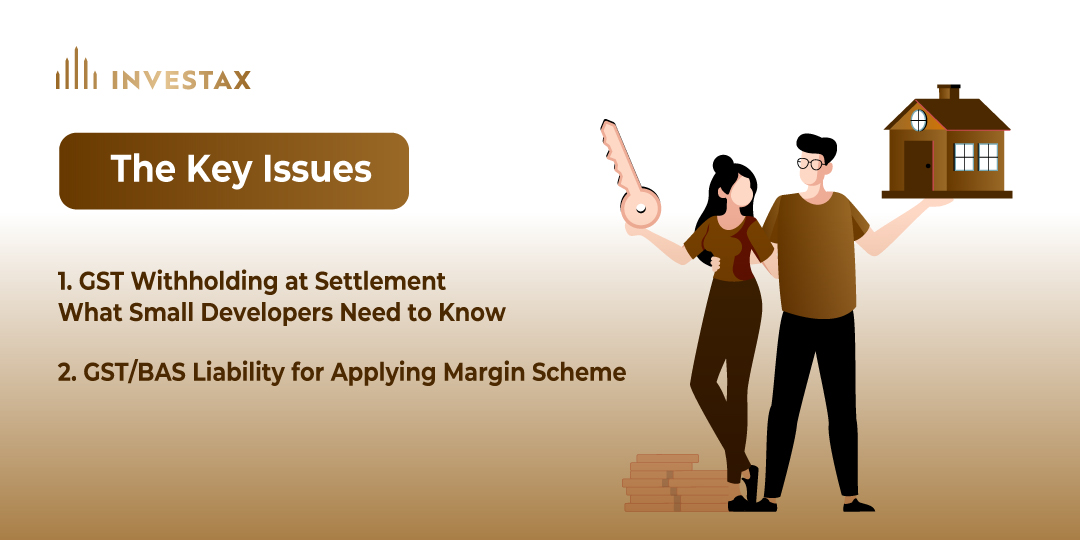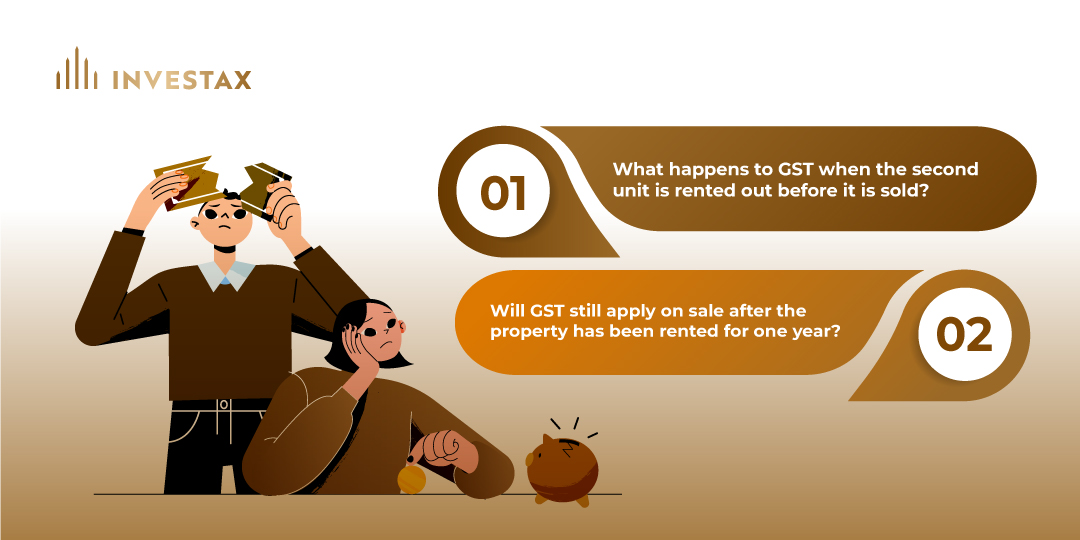Background
Mark and Cindy are passionate small-scale property developers. In 2023, they acquired a residential block, subdivided it, and developed a modern duplex with the intention of selling both properties on completion. As they are registered for GST, they claimed input tax credits on construction costs throughout the build.
Upon completion, one unit was sold under the margin scheme after three months on the market. The second, however, has taken longer to move. To make the most of a soft property market and secure some cash flow, they decided to rent out the second unit on a 12-month lease before trying to sell it next year.
With this revised plan, they turned to Investax for advice on GST obligations, adjustments, and what to expect when selling the property after renting it out.

The Key Issues
GST Withholding at Settlement – What Small Developers Need to Know
If you’re a small property developer, it’s important to understand GST withholding at settlement—a rule that has caught many new small developers by surprise. Since 1 July 2018, when you sell new residential property or potential residential land, the purchaser is required to withhold a portion of the sale price (typically 7% or 1/11th) and pay it directly to the ATO, rather than to you. This amount is then credited to your GST account and offset against your GST liability when you lodge your BAS. It’s designed to prevent non-compliance in the property industry, especially from “phoenix” developers who disappear before paying their GST. This means you won’t receive the full contract price at settlement—but it’s not a penalty; it’s simply a change in the way GST is collected. To avoid settlement delays and confusion, always include a supplier notification in your contract documents and make sure your buyers are aware of their withholding obligations.
GST/BAS Liability for Applying Margin Scheme –
When small developers like Mark and Cindy choose to apply the margin scheme on the sale of newly built property, the GST calculation—and how it’s reported on their BAS—differs significantly from standard sales.
Under the margin scheme, GST is calculated only on the “margin”—the difference between the original purchase price of the land and the final sale price of the developed property. This can substantially reduce the GST payable, especially when the property was acquired from a seller not registered for GST or from a sale where the margin scheme was already applied.
Example:
Mark and Cindy purchased a vacant lot for $400,000 (no GST claimed on land). They then spent $350,000 constructing a duplex and claimed $31,818 in GST credits (1/11th of construction costs). A year later, they sell one unit for $850,000 using the margin scheme.
The GST liability under the margin scheme would be:
- Margin = $850,000 (sale price) − $400,000 (original land cost) = $450,000
- GST Payable = 1/11th of $450,000 = $40,909

What happens to GST when the second unit is rented out before it is sold?
Because Mark and Cindy claimed GST credits on construction but are now using the property to generate input-taxed residential rent, they must review whether any increasing GST adjustments apply.
According to GST rules and GSTR 2009/4, when a new residential property is used for input-taxed purposes (like leasing), the GST credits previously claimed may need to be adjusted, depending on how the property is used over time.
- If the property is actively marketed for sale during the lease, a revenue-based method is typically used:
Adjustment = Rental Income ÷ (Rental Income + Expected Sale Price) - If not actively marketed during that time, a time-based method is more appropriate:
Adjustment = Number of days used to rent ÷ Total number of days property held - If there’s a mixture (e.g., listed for sale for the first 3 months and then delisted), a blended approach may be needed.
Each acquisition related to construction (except those under $1,000) must be assessed individually in its first adjustment period. Typically, this is the first 30 June that is more than 12 months after the GST credit was claimed.
Will GST still apply on sale after the property has been rented for one year?
Yes. If Mark and Cindy sell the second duplex after just 12 months of leasing, it will still be considered “new residential premises” under GST law. To be exempt from GST, the property would need to be used solely for residential tenancy for a full five years.
Therefore:
- The sale will trigger GST, and
- Mark and Cindy may still be eligible to apply the margin scheme, reducing the GST payable on the sale.
- GST withholding rules also apply at settlement, meaning the purchaser must withhold a portion of the sale price and remit it directly to the ATO.
Income Tax vs Capital Gains Tax – What Applies to Mark & Cindy?
For small property developers like Mark and Cindy, one common question is: “Will the profit be taxed as income or as a capital gain?” In their case—where they’ve purchased land, built a duplex, claimed GST credits, and sold the first property (and plan to sell the second after leasing it for a year)—the ATO will most likely treat the profits as ordinary income, not capital gains. This is because they are carrying on a profit-making business or venture in the nature of trade. That means the full net profit from each sale is assessable as income and taxed at their marginal tax rates.
CGT typically applies to the sale of long-term investments, not property developed for resale. Even leasing one unit for a year doesn’t shift the tax treatment unless the property is held as a rental for at least 5 years and there’s clear evidence of a change in intention—from developing to holding for long-term investment.
In short: Since they’ve built with the intention to sell and have registered for GST, the ATO will see them as developers—so income tax rules apply, not CGT concessions. Understanding this difference is crucial, especially when planning for tax on the eventual sale of the second unit.

✅ Conclusion & What You Should Do
Mark and Cindy’s journey shows how quickly a small development project can become a tax minefield if you’re not well-prepared. From navigating GST withholding at settlement to understanding margin scheme calculations, and from managing GST adjustments during leasing to realising the profits will likely be taxed as business income—not under CGT rules—there’s a lot for small developers to consider. The ATO treats projects like these as profit-making ventures, which means ordinary income tax applies—often at higher rates than capital gains. Add to that the complexity of supplier notifications, BAS reporting, and GST credits, and it’s clear: small-scale doesn’t mean simple when it comes to tax.
At Investax, we specialise in helping small property developers make confident decisions at every stage—from acquisition to construction, rental, and resale. We’ll guide you through the tax rules so you can avoid costly surprises and structure your projects for success.
Contact our property tax specialists today to discuss your next development and how we can help you optimise your GST position from day one.



